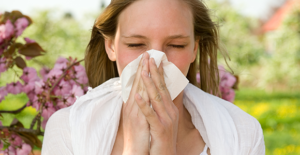What is Rhinitis?
What is Rhinitis?
Rhinitis is inflammation of the tissues inside the nose. “Rhino” refers to the nose and “itis” denotes inflammatory changes.
Regarding the anatomy of the nose and surrounding area, there are three (upper, middle, and inferior) soft tissue prominences inside the nose on each side called turbinates. These are covered with a lining membrane called mucosa. The recess between the turbinates is called a meatus. There are also tiny openings in the meatus through which the sinuses (i.e., cavities behind the cheek bones, above the eyebrows, and around the eyes within the facial bones) connect with the nose. The tear ducts drain into the upper part of the nostrils. The wall between the nostrils (partly bone and partly soft tissue) is called the nasal septum.
The nose, in addition to contributing to the contour of the face, serves three important functions. It humidifies and warms the air we breathe in. The hairs and cilia within the nose also filter the air, removing irritants and allergens to some extent. Thus the nose protects the lungs from the harmful effects of dry and cold air as well as particulate matter.
The mucous membrane inside the nose secretes clear mucus keeping the nostrils moist and cool. Inflammation of the tissues inside the nose results in two major manifestations. Swelling of the turbinates makes the nostrils narrower than normal. Severe swelling may even make the nostrils completely blocked, making breathing through the nose difficult. The second effect of inflammation is the excessive secretion of mucus which drips down from the nostrils either as a runny nose or as a post-nasal drip.
There are basically two types of rhinitis: allergic and non-allergic. An individual may have either type alone or both types simultaneously. The term “allergic” usually refers to a reaction by the immune system when it is exposed to a substance it considers harmful. It is different from a “toxic” reaction, where the strong chemical nature of a substance causes damage to the tissues and/or organs.
Though pollen and dust mites are not really harmful to us, sometimes our immune systems mistake them as potentially harmful and mount an attack on them. This attack takes the form of inflammatory changes in the tissues exposed to those substances. Allergic rhinitis (i.e., hay fever) is triggered by the exposure to allergens and results in inflammation of the nasal tissues. Molds, animal dander, and cockroaches are other common examples of innocuous substances triggering allergic responses. The tendency to cause reactions against benign substances is called “atopy.” It is genetically determined and impacts about 20 to 30% of the population.
Non-allergic rhinitis is a condition where nasal tissues are inflamed as a result of exposure to non-specific irritants such as smoke, strong odors, chemical sprays, and cold air. The exact mechanism how these substances cause rhinitis is not well understood but the effects resemble those of allergic rhinitis. Another variety of non-allergic rhinitis is called gustatory rhinitis. In gustatory rhinitis, the act of chewing triggers a reflex which produces excessive secretions resulting in a runny nose while eating. Rhinitis is often accompanied by “conjunctivitis”, which is an inflammation of the thin membrane covering the eyeballs.
The common symptoms of rhinitis are nasal congestion, copious clear runny nose, and sneezing. Sneezing is thought to be a protective reflex that attempts to forcibly expel noxious and undesirable substances from the nose. Itching, redness, and excessing tearing are the manifestations of conjunctivitis which often accompanies rhinitis. Itching can also affect the nose and ears. Excessive secretions from the nose may also drip down the back of the throat (i.e., post-nasal drip) causing a feeling of scratchiness and/or a tickling sensation of the throat which can trigger the cough reflex.
Other less common symptoms may include facial pressure, headache, and fatigue. The severity of these symptoms is responsible for the loss of several work hours and school days every year. The symptoms can be bothersome year-round (i.e., perennial) when the offending agent(s) are indoor allergens (e.g., dust mites, molds, animal dander). When pollen and molds are the triggers, the symptoms are usually seasonal. In the greater Washington, DC, Northern Virginia, and Maryland metropolitan area, the trees usually begin pollinating in late February. The grass pollen typically begins in late March/early April and lasts until the beginning of July. Ragweed and other weeds usually begin pollinating around the middle of August and subside after the first deep frost which generally occurs at the end of October.
The treatment of this very common condition usually involves a three pronged approach:
- Medications such as antihistamines, nasal sprays, and eye drops offer some temporary symptom relief, but sometimes the side-effects can be more bothersome than the symptoms.
- Environmental control to minimize exposure to the known allergens and non-specific irritants.
- Allergen immunotherapy (i.e., allergy shots, allergy injections, allergy hyposensitization, allergy desensitization) is a very effective treatment modality which can prevent symptoms by increasing the tolerance to the allergens, identified by allergy skin tests and/or blood tests.
The board certified allergy doctors at Black & Kletz Allergy have been diagnosing and treating rhinitis and conjunctivitis in both children and adultsfor more than 50 years. We have office locations in Washington, DC, McLean, VA (Tysons Corner, VA), and Manassas with on-site parking. The Washington, DC and McLean, VA offices are Metro accessible with a free shuttle that runs between our McLean, VA office and the Spring Hill metro station on the silver line. If you are suffering from rhinitis or conjunctivitis or any other allergy or asthma, please call us to schedule an appointment. You may also click Request an Appointment and we will respond within 24 hours by the next business day. The allergists at Black & Kletz Allergy are happy to help you combat your allergies in any one of our friendly and convenient office locations.













